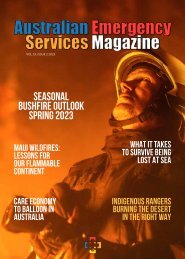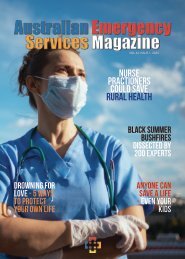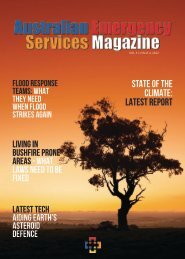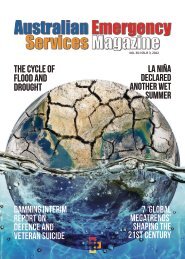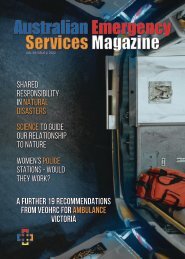Vol. 4 Issue 3. 2017
The Australian Emergency Services Magazine is a community educational resource dedicated to the recognition and promotion of emergency service personnel, and the awareness of safety measures, for the community, family and individual. We aim to provide relevant and up to date information and advancements within each of the emergency response sectors and first responders.
The Australian Emergency Services Magazine is a community educational resource dedicated to the recognition and promotion of emergency service personnel, and the awareness of safety measures, for the community, family and individual. We aim to provide relevant and up to date information and advancements within each of the emergency response sectors and first responders.
You also want an ePaper? Increase the reach of your titles
YUMPU automatically turns print PDFs into web optimized ePapers that Google loves.
Winter <strong>2017</strong><br />
The<br />
Aftermath<br />
of Cyclone<br />
Debbie<br />
Australian<br />
Authorities<br />
Combating<br />
Terrorism<br />
Drones?<br />
Our Eyes<br />
In The<br />
Skies
Mate helping Mate<br />
Neighbour helping Neighbour<br />
People helping People<br />
132 500 Fact Sheet<br />
For emergency help in floods and storms<br />
Need emergency help in floods and storms?<br />
If you need the assistance of the State Emergency Service in<br />
non-life threatening emergency situations during floods and<br />
storms, you can:<br />
• Call 132 500; or<br />
• Lodge a request here: www.132500.qld.gov.au; Or<br />
• Lodge a request on our 132 500 SES Assistance App available<br />
for both Apple and Android devices.<br />
SES volunteers help protect people and properties from storms<br />
in QLD by:<br />
• Educating people about how to protect their family and<br />
property from floods and storms<br />
• Temporarily repairing properties from further hail, heavy<br />
rain or strong wind<br />
• Clearing roads and property to give emergency access<br />
• Rescuing people trapped or injured by flood or storm activity<br />
• Providing emergency assistance in flood situations<br />
??How can I help??<br />
R Use a BUCKET to capture leaking water<br />
R MOVE furniture from under leaks<br />
R Internally TARP furniture<br />
R SANDBAG entry points to your<br />
house/business<br />
R HELP your neighbours<br />
R HELP your family<br />
Handy Hints<br />
P SES volunteers carry<br />
out temporary repairs in<br />
emergency situations<br />
P Property owners should<br />
seek professional trades<br />
people to permanently<br />
repair any damage caused<br />
by storms or floods<br />
P It is the responsibility of<br />
the landowner to remove the<br />
debris from their property<br />
Call<br />
132 500<br />
Australia<br />
Wide!<br />
If your emergency<br />
is life threatening<br />
call 000 (triple zero)<br />
For more information, contact us as per below:<br />
© State of Queensland (Queensland Fire and Emergency Services) 2016<br />
All Queensland Fire and Emergency Services material in this document – except any material protected by a trademark, and<br />
unless otherwise noted – is licensed under a Creative Commons Attribution 4.0 licence<br />
www.ses.qld.gov.au
CONTENTS<br />
Editor’s Note<br />
2<br />
Latest Events<br />
• Red Cross says Thank You<br />
• Survive & Thrive 2<br />
Symposium<br />
• Resilient Australia Awards<br />
<strong>2017</strong><br />
The Aftermath of Cyclone<br />
Debbie<br />
Eyes in the Skies<br />
Emergency Kit Essentials<br />
How to stay connected<br />
Combating Terrorism<br />
Changes to the CFA<br />
Enhancing Disaster Warnings<br />
Acupuncture used in<br />
Emergency Rooms<br />
Apps for an Emergency<br />
3<br />
4<br />
5<br />
6-9<br />
10<br />
12<br />
14-17<br />
20-23<br />
24<br />
26<br />
28<br />
33<br />
Front cover image from Japan Meteorogical Agency<br />
australian<br />
emergency<br />
services magazine<br />
www.aesj.com.au<br />
MAGAZINE CONTACTS<br />
1300 851 710<br />
press@aesj.com.au<br />
DISCLAIMER<br />
The Australian Emergency Services Magazine is a community<br />
educational resource and does not promote itself as a charity<br />
or fund raising institution, nor solicit on behalf of charities<br />
and is no way financially supported by or associated with<br />
any government or similar institution. Distributions of the<br />
publication is Quarterly and are circulated via a database of<br />
interested parties, including business, subscribers, advertisers,<br />
volunteer emergency organistations, and council libraries.<br />
A digital eMag is distributed to a targeted database in each<br />
State & Territory. All information published in the Australian<br />
Emergency Services Magazine is in good faith and whilst every<br />
effort is made to ensure that the publication is free of error<br />
and omission, no responsibility or liability will be accepted by<br />
Boothbook Pty Ltd.<br />
Published by Boothbook Media<br />
ABN:72 605 987 031<br />
www.boothbookmedia.com.au<br />
1
EDITORS NOTE<br />
2<br />
Just as our Autumn edition<br />
was being distributed, Cyclone<br />
Debbie was forming off the east<br />
coast of Queensland. None of us<br />
could have predicted the extent<br />
of the devastation or deluge that<br />
followed.<br />
The continuous powerful winds<br />
that hit North Queensland then<br />
developed into an intense rain<br />
depression that caused flooding<br />
from Queensland to New South<br />
Wales and as far reaching as New<br />
Zealand. It certainly was one of<br />
the largest systems Australia has<br />
seen for some time as the satellite<br />
images from space showed us.<br />
(See front cover)<br />
Yet again our Emergency services<br />
departments went into overdrive<br />
and provided assistance to<br />
thousands of Queenslanders<br />
immediately affected. The<br />
Australian Red Cross held a<br />
barbeque to say thankyou to<br />
these agencies for their continued<br />
support.<br />
In this Winter edtion of Australian<br />
Emergency Services Magazine, we<br />
look at the particularly unusual<br />
system Cyclone Debbie was and<br />
the flooding that followed in<br />
Northern New South Wales. As<br />
you will read the weather system<br />
was quite unpredictable.<br />
An interesting article on some<br />
new technology helping us to<br />
know how to stay connected<br />
with your mobile when often<br />
during these natural disasters our<br />
communication lines are affected.<br />
There is also an interesting<br />
development occuring in our<br />
emergency departments with<br />
the use of alternative therapies<br />
such as acupuncture to treat pain<br />
management.<br />
To all our members and<br />
supporters we hope you and your<br />
families have a safe and warm<br />
winter ahead and look forward to<br />
our next edition as we gear up for<br />
the warmth of spring!<br />
Happy Reading<br />
Emma Parker<br />
Editor
LATEST NEWS<br />
RED CROSS AND TEYS AUSTRALIA THANKS EMERGENCY<br />
SERVICE AGENCIES<br />
The Australian Red Cross and Teys<br />
Australia hosted a barbeque in April<br />
to say thankyou to the emergency<br />
responders that worked tirelessly in<br />
the wake of Cyclone Debbie.<br />
250 people took the opportunity<br />
to attend the barbeque enjoying<br />
the chance to wind down and<br />
acknowledge the hard work and new<br />
friendships and partnerships formed<br />
during the response to the latest<br />
Queensland cyclone.<br />
Australian Red Cross Central<br />
Queensland Regional Manager<br />
Janeen Miesch said, “Red Cross was<br />
involved in the response to Cyclone<br />
Debbie, and we saw emergency<br />
services people work long hours,<br />
under pressure, giving their time and<br />
effort, and sharing their expertise.<br />
“The fantastic work that was carried<br />
out by each of the agencies, and the<br />
partnerships between organisations,<br />
is truly worth acknowledging.<br />
“The barbecue is an opportunity to<br />
pat our colleagues on the back and<br />
of course to help us recover from our<br />
own personal impacts of this natural<br />
disaster.<br />
“Red Cross and Teys have been<br />
keen to show their appreciation for<br />
the work of agencies, by both staff<br />
and volunteers. Personnel from the<br />
disaster response agencies stepup<br />
repeatedly at times that can be<br />
challenging for themselves and<br />
their own families; they do this<br />
considering their community and<br />
their colleagues.”<br />
General Manager for Teys Australia<br />
in Rockhampton, Wasantha<br />
Mudannayake said Teys and Red<br />
Cross have been keen to show their<br />
appreciation for the work of agencies,<br />
by both staff and volunteers.<br />
“This barbecue offers an opportunity<br />
for us to acknowledge their<br />
contributions and hard work in<br />
response to Cyclone Debbie. The<br />
contributions of these agencies<br />
will have made such a significant<br />
difference to a large number of<br />
people, and for a long time to come,”<br />
said Mr Mudannayake said.<br />
The event was also supported by<br />
Rockhampton Regional Council,<br />
by Lions Club, Mt Archer and<br />
Castlemaine.<br />
3
LATEST NEWS<br />
SURVIVE<br />
AND THRIVE 2<br />
Paramedic Resilience Symposium<br />
Following Following the the resounding success Confirmed presenters:<br />
and interest generated in the first<br />
and Survive interest and generated Thrive Symposium in the first Tony Presentations Walker – Ambulance<br />
include:<br />
Survive held and in 2016, Thrive Survive Symposium<br />
and Thrive 2 Victoria CEO – working together<br />
held will in 2016, build on Survive the commitment and Thrive of 2 with Beyond Blue<br />
will build ANZCP, on PA the and commitment<br />
CAA to address Liz Thyer – Burnout in Australian<br />
mental health of our paramedics paramedics<br />
of these in Australia three and organisations<br />
New Zealand. Ari Peach – Is counselling<br />
to address Paramedics mental are four health times of more working for paramedics?<br />
our paramedics likely to suicide in than Australasia any other Erin Smith – The long-term<br />
and health New Zealand. professional, Paramedics<br />
we don’t want impact of 9/11 on first responders<br />
to own this statistic.<br />
Sean Thompson – Peer group case<br />
are four times more likely to studies of mental health issues<br />
suicide and support.<br />
Join than us in Melbourne, any other keep health the Terry Savage – Paramedic<br />
professional, conversation we alive don’t and take want back Personal Story<br />
the learnings to your fellow Personal Non-member paramedic rate stories $88 (inc and GST)<br />
to own this statistic.<br />
paramedics so we can build beating mental illness<br />
paramedic resilience.<br />
Black Dog Institute supporting<br />
4<br />
A one-day challenging symposium | Friday 23 June <strong>2017</strong><br />
Victoria University, Flinders Street, Melbourne Campus<br />
Presented by Paramedics Australasia, Australian<br />
Join us in Melbourne, keep the conversation alive and take back the<br />
learnings to your fellow paramedics so we can build paramedic resilience.<br />
• Tony Walker – Ambulance Victoria CEO – working together with beyondblue<br />
• Lisa Holmes – Sharing the wisdom of our veteran paramedics<br />
• Liz Thyer – Burnout in Australian paramedics<br />
• Ari Peach – Is counselling working for paramedics?<br />
• Erin Smith – The long-term impact of 9/11 on first responders<br />
• Personal paramedic stories and beating mental illness<br />
• Chris Mawson – Art therapy in PTSD<br />
• Mental health for rural and remote paramedics.<br />
Experts, presentations, panel session, personal stories, research<br />
PA and ANZCP member rate $66 (inc GST)<br />
(includes full day symposium and catering)<br />
Register at www.paramedics.org/events/<br />
first responders<br />
Mental health for rural and<br />
remote paramedics<br />
Experts, presentations, panel<br />
session, personal stories, research<br />
and support<br />
Visit the Symposium webpages<br />
with all the details
LATEST NEWS<br />
<strong>2017</strong> RESILIENT<br />
AUSTRALIA<br />
AWARDS<br />
The Resilient Australia Awards is a<br />
national program that recognises and<br />
promotes initiatives that strengthen<br />
community disaster resilience across<br />
the nation.<br />
By celebrating innovation and<br />
exemplary practice, the awards<br />
showcase work that is often unseen,<br />
motivating others to think about how<br />
they can be better prepared and more<br />
disaster resilient.<br />
The awards program started in 2000,<br />
and has a solid history in Australia’s<br />
emergency management sector.<br />
For more information, email<br />
ResilientAustraliaAwards@ag.gov.au.<br />
Applications for the <strong>2017</strong> Resilient<br />
Australia Awards are now open and<br />
close on the 30th June.<br />
Entries for this year’s awards must<br />
relate to projects/initiatives which<br />
commenced after 1 January 2015, or<br />
demonstrate significant outcomes or<br />
enhancements since 1 January 2015.<br />
The Resilient Australia Awards are<br />
proudly sponsored by the Australian<br />
Attorney-General’s Department<br />
in conjunction with the states and<br />
territories.<br />
Award eligibility information and<br />
judging criteria is detailed in the<br />
following guidelines:<br />
<strong>2017</strong> Resilient Australia Awards<br />
Guidelines that can be found on the<br />
website<br />
To submit an application, visit the<br />
<strong>2017</strong> Resilient Australia Awards<br />
website.<br />
Award categories<br />
This year’s state and territory award<br />
categories are:<br />
• Resilient Australia Business<br />
Award<br />
• Resilient Australia Community<br />
Award<br />
• Resilient Australia Government<br />
Award<br />
• Resilient Australia School Award<br />
• Resilient Australia Photography<br />
Award - People’s Choice.<br />
The winners of the state and territory<br />
award categories will automatically<br />
progress to consideration for the<br />
three national award categories:<br />
• Resilient Australia National<br />
Award<br />
• Resilient Australia National<br />
School Award<br />
• Resilient Australia National<br />
Photography Award.<br />
If you have a project which<br />
crosses over three or more states<br />
or territories, you may enter your<br />
project directly into the Resilient<br />
Australia National Award category.<br />
If you have a project which crosses<br />
over two states or territories, you may<br />
select a lead jurisdiction and enter it<br />
in the appropriate award category in<br />
that jurisdiction.<br />
The Resilient Australia National<br />
Awards will be presented at a<br />
ceremony in November-December<br />
<strong>2017</strong>.<br />
5
THE AFTERMATH<br />
OF CYCLONE<br />
DEBBIE<br />
6<br />
The devastating flood damage<br />
wreaked by Tropical Cyclone<br />
Debbie has left many residents in<br />
northern New South Wales facing<br />
an enormous cleanup that could<br />
take months.<br />
Any Lismore local will tell you<br />
that flooding is a fact of life in the<br />
Northern Rivers. In the floods of<br />
1954 and 1974, the Wilsons River<br />
rose to a record 12.17 metres. This<br />
time around, the river peaked at<br />
11.59m, breaching the flood levee<br />
built in 2005 for the first time.<br />
So what are the conditions that<br />
caused those historic floods? And<br />
are they any different to the conditions<br />
of <strong>2017</strong>?<br />
Like the current flood, cyclonic<br />
rains also caused the 1954 and<br />
1974 events. But unlike those past<br />
events, both of which were preceded<br />
by prolonged wet weather,<br />
almost all of the extreme rainfall<br />
from ex-Tropical Cyclone Debbie<br />
fell within 24 hours.<br />
More interesting still is the fact<br />
that we are not currently experiencing<br />
La Niña conditions,<br />
which have historically formed<br />
the backdrop to severe flooding in<br />
eastern Australia. The 1954 flood
was preceded by an east coast low<br />
from February 9-11, followed by<br />
a decaying tropical cyclone from<br />
February 19-22. Thirty people<br />
were killed as flood records were<br />
set in Lismore, Kyogle, Casino,<br />
Nimbin and Murwillumbah.<br />
Some places received more than<br />
1,000mm of rain in 14 days.<br />
In 1974, former Tropical Cyclone<br />
Zoe unleashed torrential rain over<br />
Lismore, Wyrallah and Coraki.<br />
From March 10-13, some stations<br />
received almost 1,000mm in just<br />
four days. One analysis described<br />
the flood as a once-in-70-year<br />
event.<br />
This time around, the remains of<br />
Tropical Cyclone Debbie delivered<br />
extreme rainfall to northern<br />
NSW towns including Murwillumbah,<br />
Chinderah and Lismore,<br />
despite having crossed the coast<br />
several days earlier and more than<br />
1,200km to the north. Floods<br />
as far apart as Rockhampton in<br />
central Queensland and northern<br />
New Zealand show the storm’s<br />
colossal area of influence.<br />
During the event, 20 rainfall stations<br />
in Queensland and 11 sites<br />
in NSW recorded their wettest<br />
March day on record. Mullumbimby,<br />
in the Brunswick River<br />
catchment, received a staggering<br />
925mm during March – over half<br />
the annual average in a single<br />
month – causing major flooding<br />
in the region.<br />
The heaviest rainfall in the Wilsons<br />
River catchment was at Terania<br />
Creek, which received 627mm<br />
over March 30-31, 99% of it in<br />
the 24 hours from 3am on March<br />
30. Lismore recorded 324.8mm<br />
of rain in the 18 hours to 3am on<br />
March 31, its wettest March day<br />
in more than 100 years. A little<br />
further out of town, floodwaters<br />
submerged the gauge at Lismore<br />
Airport, so unfortunately we do<br />
not have reliable figures for that<br />
site.<br />
The main difference between the<br />
current flooding and the 1954 and<br />
1974 floods is that the previous<br />
events both occurred against a<br />
background of sustained La Niña<br />
conditions. These tend to deliver<br />
above-average tropical cyclone<br />
activity and high rainfall totals,<br />
which increase flood risk.<br />
During the early 1970s, Australia<br />
experienced the longest period of<br />
La Niña conditions in the instrumental<br />
record. This unleashed<br />
phenomenal deluges across virtually<br />
the entire country. By the end<br />
of 1973, many catchments were<br />
already saturated as the wet season<br />
started early, culminating in the<br />
7
wettest January in Australia’s rainfall<br />
records.<br />
In 1974 the Indian Ocean was<br />
also unusually warm (what meteorologists<br />
call a “negative Indian<br />
Ocean Dipole (IOD) phase”),<br />
further enhancing rainfall in the<br />
region. When negative IOD events<br />
coincide with La Niña conditions<br />
in the tropical Pacific, the warm<br />
sea temperatures reinforce one<br />
another, resulting in more evaporation<br />
and increased rainfall.<br />
This double whammy resulted in<br />
the exceptionally wet conditions<br />
experienced across the country<br />
during 1974.<br />
In January 1974, the Northern<br />
Territory, Queensland and Australia<br />
as a whole recorded their<br />
wettest month on record, while<br />
South Australia and New South<br />
Wales recorded their second-wettest<br />
January on record. Torrential<br />
monsoon rains in the gulf country<br />
of Queensland transformed the<br />
normally dry interior into vast<br />
inland seas, flooding all the way<br />
to Lake Eyre in the arid zone of<br />
South Australia.<br />
In contrast, Tropical Cyclone<br />
Debbie formed under neutral<br />
conditions, rather than during<br />
a La Niña. In fact, the Bureau of<br />
Meteorology is currently on El<br />
Niño watch, meaning that there<br />
is double the normal risk of an El<br />
Niño event bringing low rainfall<br />
and high temperatures to Australia<br />
by mid-<strong>2017</strong>.<br />
So, unlike the 1950s and 1970s,<br />
the current flooding happened<br />
despite the absence of conditions<br />
that have driven major flooding<br />
in the past. It seems extraordinary<br />
that such a damaging cyclone<br />
could develop under these circumstances,<br />
and deliver such high<br />
rainfall over such a short time.<br />
This suggests that other factors<br />
may be at play.<br />
A rapidly warming climate means<br />
that storms are now occurring in<br />
a “super-charged” atmosphere.<br />
As temperatures increase, so does<br />
the water-holding capacity of the<br />
lower atmosphere. The oceans<br />
are also warming, especially at<br />
the surface, driving up evaporation<br />
rates. Global average surface<br />
temperature has already risen by<br />
about 1℃ above pre-industrial levels,<br />
leading to an increase of 7% in<br />
the amount of water vapour in the<br />
atmosphere.<br />
Of course, it is hard to determine<br />
the exact impact of climate change<br />
on individual storms. However,<br />
climate scientists are confident<br />
about the overall trends.<br />
Australia’s land and oceans have<br />
warmed by 1℃ since 1910, with<br />
much of this warming occurring<br />
since 1970. This influences the<br />
background conditions under<br />
which both extremes of the rainfall<br />
cycle will operate as the planet<br />
continues to warm. We have high<br />
confidence that the warming trend<br />
will increase the intensity of extreme<br />
rainfall experienced in eastern<br />
Australia, including southeast<br />
Queensland and northern NSW.<br />
While it will take more time to determine<br />
the exact factors that led<br />
8
to the extreme flooding witnessed<br />
in March <strong>2017</strong>, we cannot rule<br />
out the role of climate change as a<br />
possible contributing factor.<br />
CSIRO’s latest climate change<br />
projections predict that in a hotter<br />
climate we will experience intense<br />
dry spells interspersed with<br />
periods of increasingly extreme<br />
rainfall over much of Australia.<br />
Tropical cyclones are projected to<br />
be less frequent but more intense<br />
on average.<br />
That potentially means longer and<br />
more severe droughts, followed by<br />
deluges capable of washing away<br />
houses, roads and crops. Tropical<br />
Cyclone Debbie’s formation after<br />
the exceptionally hot summer of<br />
2016-<strong>2017</strong> may well be a perfect<br />
case in point, and an ominous sign<br />
of things to come.<br />
First published on “The<br />
Conversation”<br />
Joelle Gergis<br />
ARC DECRA Climate Research<br />
Fellow, School of Earth Sciences,<br />
University of Melbourne<br />
9
10<br />
EYES IN THE SKIES
In Australia, unmanned aerial<br />
vehicles – or drones – are now being<br />
used by the police in most states as a<br />
tool to help fight crime or to assist in<br />
rescue missions.<br />
For example, drones are being used<br />
to locate people on the ground and<br />
transmit GPS coordinates back to an<br />
operator during bushfires. They can<br />
also be used to create 3D maps of<br />
terrain in advance of an upcoming<br />
operation. And some drones can even<br />
detect chemicals or radiation.<br />
Drones are increasingly being used<br />
in law enforcement as well as in the<br />
military and by intelligence agencies.<br />
Yet, despite their benefits, some<br />
members of the public have resisted<br />
their adoption. There has also been<br />
friction between police services, civil<br />
aviation authorities and regulatory<br />
bodies that monitor privacy.<br />
The main concern is that drones,<br />
flown by either the police or the<br />
public, could unintentionally capture<br />
footage of people going about their<br />
normal life.<br />
Current privacy laws do not<br />
specifically address drones flown<br />
by the public or non-governmental<br />
organisations, leaving privacy<br />
controls largely undetermined and<br />
prosecution in the case of misuse<br />
somewhat arbitrary.<br />
Another concern is whether police<br />
will receive proper training in<br />
operating drones before they are<br />
given appropriate licenses by the<br />
relevant civil aviation authorities –<br />
especially since training can be quite<br />
expensive.<br />
Despite assurances from the police<br />
that drones are intended to be used<br />
only for specific rescue and crime<br />
fighting missions, Australians may<br />
not be convinced until formal<br />
legislation regarding privacy<br />
protection is enacted. This is<br />
particularly the case for monitoring<br />
drones flown by the public as a<br />
recreation.<br />
In the US, the debate has been even<br />
more hotly contested as drones are<br />
being openly used for surveillance.<br />
The Electronic Frontier Foundation,<br />
which is a civil liberties advocacy<br />
group, had filed a lawsuit against the<br />
Federal Aviation Authority to find<br />
out which organisations had sought<br />
permission to fly drones.<br />
Uses and abuses<br />
As with any other form of technology,<br />
benefits come with the potential for<br />
misuse. Drones are readily available<br />
and pose a risk if flown without care<br />
or training, as was case of the drone<br />
that crashed during the Cricket<br />
World Cup final at the MCG and<br />
others.<br />
The use of drones in a public<br />
environment exposes the user to<br />
prosecution. Civil aviation authorities<br />
in various countries, such as the<br />
UK, have setup a modus operandi<br />
covering how they are meant to be<br />
operated by the common user.<br />
Further, drones can be used by<br />
criminals or spies to attain valuable<br />
information or even as a way to<br />
smuggle small items. Since drones<br />
are typically quite discrete, many<br />
law enforcement agencies are using<br />
unconventional means to obstruct<br />
them, such as using other larger<br />
drones or eagles.<br />
Most current policing operations<br />
of drones have limited contact with<br />
the common user as they are mostly<br />
restricted to information gathering.<br />
However, with the advent of drone<br />
technology and an increase in<br />
autonomy, one can expect people to<br />
be much more involved.<br />
Eyes on the eyes in the skies<br />
With the growing use of drones in<br />
public environments, it is important<br />
to understand whether people<br />
accept them and how they react to<br />
drones. So we recently undertook<br />
a large-scale survey to determine<br />
public reaction to drones in different<br />
scenarios.<br />
Our research shows that the<br />
perception of drones is a delicate and<br />
complicated issue, and it is influenced<br />
by several factors such as cultural<br />
background and even gender.<br />
One interesting result was that<br />
women tended to think drones were<br />
more friendly. We can only speculate<br />
on why this was the case. But the<br />
answer may lie in gender differences<br />
observed in the perception of agentbased<br />
technology.<br />
Men are thought to prefer active and<br />
autonomous behaviour in agents<br />
and robots whereas women are more<br />
sceptical of such characteristics.<br />
Given that the drones generally<br />
operate discretely or in a subtle<br />
fashion, this may have led to women<br />
appreciating them more.<br />
Yet the two points of utmost<br />
importance for our survey<br />
respondents were safety and privacy.<br />
Some even remarked that they would<br />
feel intimidated if a drone were<br />
used in a public environment. Other<br />
research has also triggered an ethical<br />
debate on the deployment of drones<br />
in war.<br />
As with any other forms of<br />
technology, the assimilation and<br />
deployment of drones in society will<br />
require careful deliberation, proper<br />
testing and the establishment of<br />
relevant legislation.<br />
Omar Mubin<br />
Western Sydney University<br />
11
EMERGENCY KIT<br />
ESSENTIALS<br />
HAVING AN EMERGENCY KIT IS AN IMPORTANT STEP TO<br />
PREPARE FOR, SURVIVE AND COPE WITH EMERGENCIES.<br />
Know<br />
All householders need to<br />
know where your<br />
Emergency Kit is kept.<br />
On this page is a list of items which should be in your<br />
kit at all times. There is also a list of extra items which<br />
if you do not keep at all times you should add to your<br />
kit during storm or cyclone season.<br />
FOOD AND WATER<br />
COMMUNICATIONS<br />
Check<br />
and update the contents<br />
of your kit regularly, to<br />
ensure everything is in<br />
working order and has<br />
not expired.<br />
Discuss<br />
your Emergency Kit<br />
with all householders<br />
and make sure everyone<br />
knows what to do in an<br />
emergency.<br />
KNOW YOUR<br />
EMERGENCY<br />
CONTACTS<br />
Range of non-perishable<br />
MEDICAL AND<br />
SANITATION<br />
food items<br />
Bottled water<br />
First Aid Kit and manual<br />
Essential medications,<br />
prescriptions and dosage<br />
Toilet paper<br />
Toothbrush/toothpaste<br />
Soap/shampoo<br />
Personal hygiene items<br />
LIGHT<br />
Flashlight/torch with<br />
extra batteries<br />
Battery powered lantern<br />
Battery powered radio with<br />
extra batteries<br />
Traditional wired telephone<br />
Prepaid wired telephone<br />
Prepaid phone cards and<br />
coins for phone calls<br />
CLOTHING AND<br />
FOOTWEAR<br />
Warm jumper, waterproof<br />
jacket, hat and gloves<br />
for everyone<br />
Closed-toed shoes or<br />
boots for everyone<br />
TOOLS AND SUPPLIES<br />
Whistle, utility knife,<br />
duct/masking tape<br />
12
Plastic garbage bags, ties<br />
Safety glasses and sun glasses.<br />
MISCELLANEOUS<br />
Special items for infants<br />
(nappies, formula etc)<br />
Special items needed by<br />
elderly or people with<br />
special needs<br />
Spare house and car keys<br />
Pet food, water and<br />
other animal needs<br />
IMPORTANT DOCUMENTS<br />
Keep original or certified copies of<br />
these documents in your Emergency<br />
Kit.<br />
Scan copies of them and save the<br />
files on a USB memory stick or CD<br />
to include in your kit. Keep all these<br />
items in sealed plastic bags.<br />
Insurance papers for your<br />
house and contents, cars<br />
and for valuable items<br />
Inventory of valuable<br />
household goods<br />
Wills and life insurance documents<br />
House deeds/mortgage documents<br />
Birth and marriage certificates<br />
Passports/visa details<br />
Stocks and bonds<br />
Medicare, pension cards,<br />
immunisation records<br />
Bank account and credit card details<br />
A back-up copy of important<br />
computer files<br />
Household Emergency Plan with<br />
emergency contact numbers<br />
FOR MORE INFORMATION AND TO DOWNLOAD AN<br />
EMERGENCY PLAN FOR YOUR HOUSEHOLD GO TO:<br />
www.qld.gov.au/emergency/dealing-disasters/emergency-kit<br />
13
14
HOW TO STAY CONNECTED<br />
WHEN THE NETWORK IS<br />
DOWN<br />
When Tropical Cyclone Debbie hit<br />
Queensland this week, one of the<br />
casualties was the region’s mobile<br />
phone network.<br />
Phone towers can stop working<br />
because they have been damaged by<br />
the wind, or because they have run<br />
out of diesel to run their generators.<br />
Whatever the cause, the end result<br />
is the same: a number of people<br />
will find their mobile phones not<br />
connected to the network, leaving<br />
them without communications for<br />
an extended period of time.<br />
It’s not just tropical cyclones that<br />
can affect mobile communications.<br />
Bushfires and other disasters can<br />
also lead to a break in the network.<br />
This loss of communication is<br />
extremely isolating, and potentially<br />
very dangerous. Whether it’s the<br />
inability to call an ambulance or the<br />
absence of regular safety warnings,<br />
a lack of communications can be<br />
life-threatening.<br />
The sensation of being cut off from<br />
the rest of the world also brings<br />
with it a danger of a different kind.<br />
Severe isolation can cause concern<br />
15
for our loved ones. This very human<br />
problem is what led me to start my<br />
research in this area.<br />
So how can we let people<br />
communicate using their mobile<br />
phones, when the phone network<br />
isn’t available?<br />
For nationwide communications,<br />
you really do need phone towers<br />
and their supporting infrastructure.<br />
There currently just aren’t any good<br />
alternative solutions to providing<br />
communications on such a large<br />
scale.<br />
But if you change the scope of the<br />
solution to focus more on internal<br />
communications within smaller<br />
communities, alternatives suddenly<br />
begin to present themselves.<br />
I have spent the past seven years<br />
designing low-cost devices and<br />
free software to try to solve this<br />
problem. From this research and<br />
design process emerged the Serval<br />
Project. The concept is simple: we<br />
create Mesh Extender devices that<br />
act as communications hubs.<br />
Mobile phones connect to Mesh<br />
Extenders using ordinary Wi-Fi.<br />
The Mesh Extender devices then<br />
relay communications between<br />
other mobile phones using an app<br />
that can be downloaded from the<br />
Mesh Extender itself. No internet or<br />
cellular network is required.<br />
Compatibility is currently limited<br />
to Android devices with the hope of<br />
expanding to other providers as the<br />
project grows.<br />
Installation of the app is all that is<br />
required to connect a mobile phone<br />
to the Mesh Extender system, and<br />
all communication that takes place<br />
on the network is encrypted, so the<br />
user’s privacy remains secure.<br />
They system currently operates<br />
within a closed network, only<br />
connecting with mobile phones<br />
that already have the app installed.<br />
To connect with existing phone<br />
networks, partnerships with<br />
existing mobile operators would<br />
need to be formed in the future.<br />
The advantage of using Wi-Fi is that<br />
it is already in almost every mobile<br />
phone on the planet. Its range,<br />
however, it still quite limited.<br />
So to make our system work<br />
over useful distances, the<br />
Mesh Extenders have a second<br />
radio installed. That radio can<br />
communicate over several<br />
kilometres, as long as there are no<br />
significant obstacles.<br />
The Mesh Extenders can also<br />
automatically relay among<br />
themselves, moving messages like a<br />
bucket brigade. This fully automatic<br />
operation makes it easy to build<br />
larger networks quickly, and also<br />
lets the network connect around<br />
Australia Ltd<br />
www.imcdgroup.com<br />
Detergents Pharmaceuticals Personal Care<br />
IMCD is a global leader in the sales, marketing<br />
and distribution of speciality chemicals and food<br />
ingredients. Through our technical, marketing<br />
and supply chain expertise we bring added<br />
value and growth to both our customers and<br />
principal partners throughout the world.<br />
Coatings<br />
Home care, industrial<br />
care and institutional care<br />
Pharmaceutical synthesis, innovative (brand)<br />
pharmaceuticals, generic pharmaceuticals,<br />
neutraceuticals or food supplements, veterinary<br />
Colour cosmetics, dental, deodorants,<br />
fragrances, hair care, skin care and toiletries<br />
Adhesives, construction inks,<br />
industrial coatings, paints<br />
Food & Nutrition<br />
Lubricants<br />
Synthesis<br />
Plastics<br />
Bakery, beverages, confectionary,<br />
dairy, edible oils & fats, nutrition,<br />
savoury, animal nutrition<br />
Automotive, industrial,<br />
fuel & refinery<br />
Resins, polymers, esters, plasticisers,<br />
pigments & dyes, surfactants,<br />
floculants, various additives<br />
Compounders, converters, rubbers,<br />
polyurethanes and composites<br />
IMCD Australia firmly believes in offering innovative solutions that meet sustainable demands as well as making a positive contribution to its local communities.<br />
Block 6/113 Unwin Street ROSEHILL NSW 2142 02 9897 6100<br />
16
obstacles, such as hills, that might<br />
prevent a direct link.<br />
At the moment, this idea is still<br />
experimental. We have built<br />
prototype devices and apps, but<br />
they have not yet been widely<br />
tested.<br />
This is starting to change. In<br />
2016, the Serval Project was<br />
selected as one of five winning<br />
innovators to take part in the<br />
Pacific Humanitarian Challenge,<br />
a program by the Department of<br />
Foreign Affairs and Trade’s (DFAT)<br />
InnovationXchange that aims to<br />
rethink the Australian response<br />
to humanitarian disasters in the<br />
Pacific.<br />
We are now getting ready to test<br />
our technologies in Vanuatu later<br />
this year. Our goal is simple:<br />
to understand how useful our<br />
solutions are today, and to identify<br />
the areas where we can improve<br />
them.<br />
The pilot is an important step<br />
in our quest to provide effective<br />
communication alternatives.<br />
Not only will it help us to meet<br />
the needs of vulnerable Pacific<br />
Island populations during times<br />
of disaster, but it will also help<br />
us to better understand how this<br />
technology could be used locally in<br />
Australia.<br />
Its use in cyclones and bushfires<br />
here immediately come to mind.<br />
But our technology could also<br />
be used to assist remote, isolated<br />
Australian communities with little<br />
to no communication options.<br />
If you can make something simple<br />
and robust enough to use during a<br />
natural disaster, then it’s going to<br />
be able to handle a variety of other<br />
uses as well.<br />
These technologies can be used<br />
to create an internet-less system,<br />
similar to the “Internet of Things”,<br />
but one that connects a range of<br />
devices without the need to be<br />
online.<br />
Farmers, for example, in regions<br />
where connection to the internet is<br />
impossible, could use this system<br />
to remotely control water pumps or<br />
monitor feral dog traps, saving time<br />
and vehicle wear.<br />
More efficient land management<br />
increases the capacity and<br />
productivity of the land. The end<br />
result is more profitable farms.<br />
Unlike some existing farm<br />
automation systems, our<br />
technologies are cheap and simple<br />
enough for the smallest of family<br />
farms to use.<br />
Being able to help family farms<br />
is important. It is these farming<br />
families that build the heart and<br />
soul of our remote communities,<br />
through the need for schools, shops,<br />
hospitals and other services.<br />
If we can make their lives easier,<br />
safer and more productive through<br />
better local communications, we<br />
stand a chance of improving the<br />
long-term financial prosperity of<br />
farms<br />
So what started out as a foreign aid<br />
project has evolved to incorporate<br />
the needs of Australians into its<br />
design.<br />
Paul Gardner-Stephen<br />
Senior Lecturer, Flinders University<br />
First published on “The<br />
Conversation”<br />
17
18
19
AUSTRALIAN AUTHOR<br />
COMBATING TERROR<br />
20
ITIES<br />
ISM<br />
The recent terror attacks in London<br />
and Manchester have raised concerns<br />
about whether authorities here in<br />
Australia are doing enough to combat<br />
terrorism.<br />
These events have led to accusations<br />
that police and security agencies are<br />
not being upfront about the threat<br />
of terrorism – in particular Islamist<br />
terrorism. It has been suggested<br />
they are in denial about the link<br />
between terrorism, refugees and<br />
Islam, and are too concerned with<br />
maintaining good relationships with<br />
the Muslim community. Much of<br />
this commentary overlooks some key<br />
points.<br />
First, the threat we face from<br />
terrorism in Australia is completely<br />
different from the UK or the rest of<br />
Europe. These countries face a higher<br />
number of terrorist threats from<br />
returning foreign fighters, and more<br />
people on terrorist watchlists.<br />
This is not to diminish the threat we<br />
face domestically. Hence Australian<br />
authorities have on all fronts<br />
been developing comprehensive<br />
responses. These include the<br />
introduction of laws targeting foreign<br />
fighters, preventive legislation<br />
aimed at detained terrorists,<br />
deradicalisation programs in prisons,<br />
the establishment of state-based<br />
diversion teams that target those<br />
identified as at risk of radicalising to<br />
violent extremism, counter-terrorism<br />
hotlines and various local projects<br />
supporting grassroots efforts to tackle<br />
radicalisation and violent extremism.<br />
Some commentators may argue<br />
we don’t actually know if these<br />
approaches or programs work, or<br />
that these have failed to prevent<br />
terrorism. But it is early days and<br />
some programs have only recently<br />
been established.<br />
Tackling violent extremism is an<br />
evolving issue. But there is much<br />
evidence to indicate Australian<br />
authorities’ strategies hold great<br />
promise.<br />
When an individual commits a<br />
terrorist act – particularly someone<br />
previously known to police – it is<br />
a hard reminder of the limits of<br />
counter-terrorism efforts. It should<br />
be an opportunity to reflect on<br />
whether we have the right mix of<br />
legal and preventive responses, while<br />
remembering that legal responses<br />
based on detection and detention<br />
have their limitations.<br />
If we really want to be able to tackle<br />
violent extremism, we need to have<br />
an open debate and deal with some<br />
21
difficult issues.<br />
As I have argued before, we need to<br />
consider a range of causes. Singling<br />
out and overemphasising one – such<br />
as religion or refugee intakes from<br />
Muslim countries – only inhibits a<br />
comprehensive policy response.<br />
Leading academics in terrorism<br />
research have argued that we need to<br />
take the role of faith-based ideology<br />
seriously in understanding terrorism<br />
and its prevention. This is because<br />
groups like Islamic State take it<br />
seriously. They emphasise ideological<br />
rationalisations to justify their actions<br />
and attract fellow Muslims to their<br />
cause.<br />
But this does not mean it is the<br />
most significant factor in leading<br />
Muslims to commit acts of terrorism.<br />
Likewise, just because a number of<br />
terrorist episodes in Australia have<br />
involved individuals with a refugee<br />
background, that does not mean one<br />
causes the other. In other words,<br />
correlation doesn’t equal cause.<br />
Attacking the head of ASIO as<br />
somehow being in denial about<br />
the link doesn’t not help us get any<br />
closer to how we can best tackle the<br />
threat of violent extremism. There<br />
are multiple pathways into and away<br />
from violent extremism.<br />
For instance, research has shown that<br />
peers, associates and families play key<br />
roles in the radicalisation process.<br />
That is, they help reinforce personnel<br />
grievances and the jihadist ideology,<br />
providing the intent and capability to<br />
commit acts of terrorism.<br />
This is why former prime minister<br />
Tony Abbott’s comments, made<br />
after the London attacks, that<br />
“officials were too concerned<br />
about maintaining relations with<br />
the Muslim community” or that<br />
“Islamophobia, unlike terrorism, has<br />
never killed anyone” are mystifying.<br />
The police maintaining good<br />
relations with the Muslim community<br />
is essential to the passing of<br />
intelligence to police and in helping<br />
to identify youth at risk. Episodes of<br />
Islamophobia only further alienate<br />
the Muslim community. Making<br />
Muslims feel like they don’t belong<br />
is an identified pathway into violent<br />
extremism.<br />
It’s important to keep in mind that<br />
one of the aims of terrorism is not<br />
just to take human life, but to instil<br />
fear in the broader population.<br />
The loss of life to terrorism<br />
understandably provokes a demand<br />
for a forceful response. Tough<br />
language like “enough is enough”<br />
is important in offering public<br />
reassurance governments are taking<br />
the issue seriously.<br />
But we have to keep in mind that a<br />
goal of terrorism is to provoke an<br />
overreaction and create divisions in<br />
society. Jihadi ideologue Abu Bakr<br />
Sydney Events Centre. The Ultimate Event Experience.<br />
www.candlelightreception.com.au<br />
70 years of award winning residential and in-home aged care services<br />
www.whiddon.com.au<br />
RESIDENTIAL CARE<br />
COMMUNITY CARE<br />
INDEPENDENT LIVING<br />
DISABILITY CARE<br />
Experience our unique function and wedding venue.<br />
Our experienced team will help you create the perfect<br />
event to be remembered for years to come.<br />
22<br />
WEDDINGS CORPORATE FUNCTIONS<br />
BIRTHDAY CELEBRATIONS SCHOOL FORMALS<br />
17 South Terrace, Punchbowl NSW<br />
adam@aans.com.au<br />
02 9793 1887<br />
0451 188 006<br />
81 BELMONT ROAD<br />
GLENFIELD NSW 2167<br />
1300 738 388
Naji in his treatise the Management<br />
of Savagery – the textbook that<br />
has guided much of Islamic State’s<br />
brutality – stated that this should be<br />
a key goal of violent jihad. We should<br />
be mindful of not falling into this<br />
trap.<br />
Adrian Cherney<br />
Associate Professor, School of<br />
Social Science, The University of<br />
Queensland<br />
First Published “The Conversation”<br />
Stephen Young<br />
Lawyers<br />
Stephen Young Lawyers is a boutique law firm situated in the heart of Parramatta.<br />
Our practice specialises in personal injury law, commercial law and conveyancing.<br />
We are dedicated in providing a personal, professional and friendly service.<br />
We speak English, Cantonese and Mandarin.<br />
02 9635 0889<br />
www.stephenyounglawyers.com.au<br />
Suite 612 Level 6, 118 Church Street Parramatta NSW<br />
PREMIUM QUALITY<br />
AUTO GLASS SERVICE<br />
WINDSCREEN REPLACEMENT<br />
CHIP REPAIR<br />
RESEAL<br />
HOME OR WORKPLACE<br />
‘If it moves and has glass we can fix it!’<br />
michael@mjrautoglass.com.au<br />
www.mjrautoglass.epage.at/<br />
PO BOX 8098 GUNDAROO NSW 2620<br />
23
CHANGES TO THE<br />
CFA<br />
VOLUNTEERS ONLY<br />
24<br />
The CFA will be a volunteer-only<br />
firefighting service and the role of<br />
volunteers further enshrined under<br />
law, while a new organisation Fire<br />
Rescue Victoria will be established<br />
to fight fires in Melbourne and major<br />
regional centres, in much-needed<br />
and overdue reforms to the state’s fire<br />
services that will keep Victorians safe.<br />
Victoria has some of the best<br />
firefighters in the world, but they<br />
currently operate under systems and<br />
structures that have not changed<br />
since the 1950s.<br />
In just the last decade, eight reviews<br />
have been undertaken into Victoria’s<br />
fire services, including the Victorian<br />
Bushfires Royal Commission. They<br />
have made it clear that the state’s<br />
services are in need of modernisation.<br />
The Victorian Government’s changes,<br />
outlined as part of the Fire Services<br />
Statement, will respond to these<br />
issues, and ensure Victorians can rely<br />
on modern and local fire services to<br />
keep them safe, regardless of where<br />
they live.<br />
Under the reforms, the CFA will<br />
be further protected under law as a<br />
volunteer service and our 1,220 CFA<br />
brigades will continue to serve their<br />
communities as they have always<br />
done, as well as providing vital surge<br />
capacity during major emergencies.<br />
Importantly, CFA volunteers
currently serving at one of the state’s<br />
35 integrated stations will be able to<br />
remain at that station, co-locating<br />
with Fire Rescue Victoria services.<br />
Additionally, the Government will<br />
make sure CFA volunteers have the<br />
equipment and support they need,<br />
with a dedicated $56.2 million CFA<br />
Support Fund to strengthen volunteer<br />
recruitment, training, brigade<br />
support and leadership.<br />
The new Fire Rescue Victoria will<br />
be established to fight fires in major<br />
regional cities and Melbourne,<br />
bringing together the MFB and career<br />
staff from the state’s 35 integrated<br />
CFA stations, including the 450 extra<br />
career firefighters currently being<br />
delivered.<br />
Fire Rescue Victoria will be based<br />
on other successful police and<br />
emergency services organisations,<br />
including the model in New South<br />
Wales, and be led by its own<br />
Commissioner.<br />
Consistent with Recommendation<br />
63 of the Victorian Bushfires Royal<br />
Commission, an independent<br />
Fire District Review Panel will<br />
also be established. The Panel<br />
will conduct future reviews of the<br />
boundary between fire services,<br />
based on population growth, urban<br />
development and the volume of<br />
Triple 000 calls.<br />
Victoria’s emergency services will<br />
also have the very best facilities and<br />
equipment, with the establishment<br />
of a new Emergency Services<br />
Infrastructure Authority. One of<br />
the first tasks for the new authority<br />
will be to work with the CFA on<br />
delivering a new $44 million station<br />
building program.<br />
The reforms include driving cultural<br />
change, including an ambitious target<br />
to quadruple the number of career<br />
female firefighters in our fire services<br />
from 100 to 400, within 4 years. We<br />
will also increase the number of<br />
women in CFA brigade leadership<br />
roles from 265 to 909 over the same<br />
period.<br />
To roll out these reforms, an<br />
Operational Implementation<br />
Committee will be established and<br />
chaired by Mr Greg Mullins AFSM,<br />
former Commissioner of Fire and<br />
Rescue NSW.<br />
Fire and rescue services will continue<br />
as normal, and the amount collected<br />
through the Fire Services Property<br />
Levy will not change over the next<br />
two years while the reforms are<br />
implemented.<br />
State Government of Victoria<br />
www.vic.gov.au<br />
Hawkesbury Water Taxi<br />
Family owned & operated for over 35 years<br />
0422 300 100<br />
FAST CONVENIENT RELIABLE AFFORDABLE<br />
No matter where you need to go,<br />
we can get you there.<br />
Our 17-seat water taxi and 6-seat<br />
self drive runabouts, are the perfect<br />
way to travel the beautiful Hawkesbury River.<br />
TAXI SERVICES<br />
PRIVATE CHARTERS<br />
RUNABOUTS FOR HIRE<br />
www.hawkesburywatertaxi.com.au<br />
hawkesburywatertaxi@gmail.com<br />
PO Box 94 BROOKLYN NSW<br />
www.bullfrogs.com<br />
FURNITURE STATUES OTHER DECOR<br />
Stunning modern &<br />
classic Balinese<br />
furniture<br />
Various types of<br />
statues from the<br />
popular to the rare<br />
Be inspired by our<br />
broad collection of<br />
Balinese home decor<br />
“Bring the Resort Look at Home”<br />
Balinese Decor and Furniture Mornington Peninsula<br />
03 5973 6308 0400 025 828<br />
Visit our showroom at:<br />
Factory 3 1 Watt Road<br />
MORNINGTON VIC<br />
simon.kennedy3@bigpond.com<br />
25
ENHANCING EMERGENCY WARNINGS<br />
26<br />
With the multitude of warnings<br />
issued when an emergency hits, how<br />
can emergency services ensure their<br />
critical safety advice is received and<br />
acted upon, rather than dismissed<br />
as noise? Bushfire and Natural<br />
Hazards CRC research undertaken<br />
through the Queensland University<br />
of Technology is helping emergency<br />
services warn communities when<br />
danger strikes.<br />
The research involves testing the<br />
wording and structure of warning<br />
messages to better understand how<br />
messages are understood and how<br />
they might be translated into direct<br />
action. The Connecting Communities<br />
and Resilience team, led by Professor<br />
Vivienne Tippett, is supporting both<br />
individual organisations and national<br />
initiatives, providing reviews and<br />
assisting with the development of<br />
evidence-based warning doctrine.<br />
The researchers are collaborating<br />
closely with the industry, with the<br />
Inspector-General of Emergency<br />
Management Queensland,<br />
Queensland Fire and Emergency<br />
Services, Emergency Management<br />
Victoria, Victoria State Emergency<br />
Service, Country Fire Authority,<br />
NSW State Emergency Service,<br />
Country Fire Service, the Department<br />
of Fire and Emergency Services<br />
Western Australia and the Bureau of<br />
Meteorology all requesting reviews of<br />
their warnings information.<br />
Katherine Philp, Manager Regional<br />
Engagement at the Bureau of
Meteorology, believes the research is<br />
providing valuable insights that will<br />
make a difference.<br />
‘We are working to constantly<br />
improve our communication,<br />
particularly during severe weather,<br />
so the observations and findings of<br />
this research are of huge interest,’ Ms<br />
Philip said.<br />
Local councils are also benefiting.<br />
The Bundaberg Regional Council<br />
is looking at the frequency of<br />
their warnings, the wording of the<br />
information they disseminate during<br />
an emergency, and the delivery<br />
methods.<br />
‘Improvements to existing, preformatted<br />
warnings will be captured<br />
in the next review of the Bundaberg<br />
Local Disaster Management Plan and<br />
subordinate plans,’ said Matt Dyer,<br />
the council’s Disaster Management<br />
Officer.<br />
The council is also considering<br />
how to involve the community<br />
in future warnings development<br />
and identifying how local citizens<br />
could best receive warnings that are<br />
effective and timely.<br />
Minds have been expanded;<br />
opportunities have been glimpsed<br />
and a realisation had that there<br />
is an existing and emerging<br />
body of information that can be<br />
integrated into local arrangements.<br />
The Bundaberg Local Disaster<br />
Management Group is proud to<br />
model an example of how to build<br />
relationships across sectors to the<br />
greater disaster management good,’<br />
Ms Dyer said.<br />
SEQwater, a statutory authority in<br />
Queensland, is also benefiting from<br />
the study. The organisation has<br />
sought input from the team on how<br />
to improve their messaging about<br />
releasing water from dams during a<br />
flood. The aim is to achieve proactive<br />
action by the community.<br />
This research has wide-reaching<br />
implications. The Australian<br />
Broadcasting Commission local<br />
radio in Wide Bay, Queensland is<br />
working with the research team to<br />
look at ways they can improve their<br />
emergency broadcasting.<br />
Nathan Maddock, Bushfire and<br />
Natural Hazards CRC<br />
HEADQUARTERS FOR RESEARCH, DESIGN,<br />
DEVELOPMENT AND PRODUCTION OF EOS<br />
MILITARY SECTOR PRODUCTS IN AUSTRALIA<br />
DEFENCE SYSTEMS<br />
www.eos-aus.com<br />
02 6298 8000<br />
55A MONARO STREET QUEANBEYAN NSW<br />
INTERPRET PLUMBING<br />
PLUMBING DESIGN & CONSULTING NEW RESIDENTIAL PLUMBING PLUMBING RENOVATIONS LIGHT COMMERCIAL & INDUSTRIAL<br />
Sewer and stormwater drainage<br />
Detailed trenching and boring<br />
Septic and waste water systems<br />
Fresh water supply connections and reticulation<br />
Rainwater tanks & pumps<br />
Hot water systems including solar hot water systems and heat pump systems<br />
Underfloor heating<br />
General/ongoing plumbing maintenance including resolving blocked drains and CCTV drain inspections<br />
WE OFFER A WIDE RANGE OF PLUMBING SERVICES<br />
www.interpretplumbing.com.au<br />
PTY LTD<br />
chris@interpretplumbing.com.au<br />
0434 541 290 121 THE AVENUE, GRANVILLE NSW<br />
27
EMERGENCY ROOMS USING<br />
ACUPUNCTURE TO TREAT<br />
PAIN<br />
A recent study conducted by RMIT University looks at the use of acupuncture<br />
for pain relief across Australian hospitals. The study has been published in the<br />
Medical Journal of Australia<br />
28
Emergency medicine is not all about life and death<br />
situations and high-tech solutions. Our study,<br />
the largest of its kind in the world, shows using<br />
acupuncture in the emergency department can relieve<br />
acute pain.<br />
The study, published in the Medical Journal of<br />
Australia, finds acupuncture is as effective as<br />
medication in treating pain for lower back pain and<br />
ankle sprain. But it took more than an hour for either<br />
to provide adequate pain relief.<br />
Our study builds on previous research to show the<br />
effectiveness of acupuncture to treat chronic (longterm)<br />
pain.<br />
Yet, there are several barriers to using acupuncture<br />
routinely in emergency departments.<br />
WUJAL WUJAL<br />
ABORIGINAL<br />
SHIRE COUNCIL<br />
Covering an area of 64 hectares, Wujal Wujal is<br />
nestled in a World Heritage listed area along<br />
the banks of the Bloomield river.<br />
Opening Hours:<br />
1 Hartwig Street, Wujal Wujal QLD 4895<br />
Monday - Thursday 8:00am - 12:00pm<br />
1:00pm - 5:00pm<br />
Friday<br />
8:00am - 12:00pm<br />
Contact: Ph: 07 4083 9100 Fax: 07 4060 8250<br />
enquiries@wujalwujalcouncil.qld.gov.au<br />
www.wujalwujalcouncil.qld.gov.au<br />
Professional<br />
Educational<br />
Inspiring<br />
07 4237 8802<br />
Devoted, professionally qualified and experienced staff<br />
From 6wks - 5yrs<br />
Petit Early Learning Journey provides a secure<br />
and compassionate environment to enhance<br />
awareness of your child’s inner strengths,<br />
esteem as individuals, dignity and autonomy,<br />
self-confidence and enthusiasm for learning.<br />
www.petitjourney.com.au<br />
portdouglas@petitjourney.com.au<br />
Cnr Old Port Road & Captain Cook Hwy CRAIGLIE QLD<br />
29
What is acupuncture and who<br />
practices it?<br />
Using acupuncture to relieve pain<br />
involves placing needles in various<br />
parts of the body to stimulate the<br />
release of endorphins and other<br />
neurochemicals, which can act as<br />
the body’s naturally occurring pain<br />
relievers.<br />
For generations various cultures<br />
around the world have used<br />
acupuncture to treat multiple<br />
conditions, including providing<br />
pain relief. And in Australia, it is<br />
reimbursed through the Medicare<br />
Benefits Schedule when administered<br />
by a medical doctor.<br />
Acupuncture is one of the most<br />
accepted forms of complementary<br />
medicine among Australian general<br />
practitioners. It also appears in<br />
treatment guidelines for doctors in<br />
how to manage pain.<br />
Why we ran the study and what we<br />
did<br />
Anecdotally, we were aware that<br />
several emergency department<br />
doctors, in both public and private<br />
hospitals in Australia, were treating<br />
patients’ pain with acupuncture.<br />
But until this large federally-funded<br />
study, no-one had set up a trial like it<br />
to show how effective it was.<br />
Our trial was an “equivalence” study,<br />
which means we aimed to see if the<br />
different treatments were equivalent<br />
rather than seeing if they were better<br />
than placebo. We did this as it would<br />
not be ethical to give a placebo to<br />
people coming to an emergency<br />
department for pain relief.<br />
So, we randomly assigned more<br />
than 500 patients to receive standard<br />
painkillers, standard painkillers plus<br />
acupuncture, or acupuncture alone<br />
when they presented with back pain,<br />
migraine or ankle sprain at four<br />
Melbourne hospitals (some private,<br />
some public). While the patients<br />
knew which treatment they had, the<br />
researchers involved in assessing their<br />
pain didn’t (known as a single-blind<br />
study).<br />
The type of acupuncture we used<br />
included applying needles at specific<br />
points on the body for each condition,<br />
as well as along points chosen by the<br />
treating acupuncturist. This was to<br />
reflect what would happen during<br />
regular clinical practice.<br />
Doctors who were also qualified<br />
medical acupuncturists and<br />
practitioners of traditional Chinese<br />
medicine (registered in Victoria with<br />
the Chinese Medicine Registration<br />
Board of Australia) performed the<br />
acupuncture.<br />
After treatment, we assessed patients’<br />
pain after an hour, and every hour<br />
until discharge. We also rang them<br />
for an update 24-48 hours after being<br />
MAC<br />
REAL ESTATE<br />
MAC Real Estate your independent agency servicing South East Queensland<br />
Commercial Tiling Services WA<br />
Quality Commitment Reputation<br />
Specialising in high profile, public and private architecture<br />
30<br />
www.mcrestate.com.au<br />
COMMITTED TO PROVIDING A PROFESSIONAL AND<br />
PERSONALISED SERVICE TO ALL OUR CLIENTELE<br />
BUYING SELLING INVESTMENT PROPERTY<br />
PROPERTY MANAGEMENT<br />
07 3208 8887<br />
0414 321 404<br />
mac.re@hotmail.com<br />
PO BOX 232 Springwood QLD<br />
Skills, knowledge and expertise to deliver an<br />
outstanding result on every project<br />
08 9200 6191<br />
www.commercialtilingservices.com.au<br />
linda@commercialtiling.com.au<br />
42 Wittenoom Street EAST PERTH WA
discharged.<br />
What we found<br />
We found acupuncture, either alone<br />
or with painkillers, was equivalent to<br />
drugs-alone in providing pain relief<br />
for lower back pain, ankle sprain, but<br />
not for migraine.<br />
When patients looked back on<br />
their treatment, the vast majority<br />
(around 80%) were satisfied with<br />
their treatment regardless of which<br />
treatment they had.<br />
However, no treatment provided<br />
good pain relief until after the first<br />
hour.<br />
What are the implications?<br />
Our findings suggest acupuncture<br />
may be a viable option for patients<br />
who come to the emergency<br />
department for pain relief. This<br />
is especially important for those<br />
who cannot or choose not to have<br />
analgesic drugs.<br />
This is also an important finding in<br />
light of the potential for side effects<br />
and abuse with opioid analgesics,<br />
which might otherwise be used<br />
to relieve pain in the emergency<br />
department.<br />
Previous research shows using<br />
acupuncture to treat chronic pain<br />
is comparable to morphine, is safer<br />
and doesn’t lead to dependence. Our<br />
findings suggest acupuncture also has<br />
a role in treating acute pain.<br />
However, our research raises<br />
several issues, not only about<br />
conducting such research but also<br />
in implementing our findings in<br />
practice.<br />
We had to overcome many ethical,<br />
policy and regulatory issues before<br />
we started. These included issues<br />
around the qualifications of medical<br />
and non-medical acupuncturists<br />
and employing traditional Chinese<br />
medicine practitioners to deliver<br />
acupuncture in a western medical<br />
hospital.<br />
And to more widely implement our<br />
findings, we need to discuss the type<br />
of practitioners best placed to deliver<br />
acupuncture in hospital, what type<br />
of training they need to work in the<br />
emergency department and what type<br />
of conditions they should treat.<br />
Hopefully, our study will spark<br />
further research to address these<br />
issues and lead to the development<br />
of safe and effective protocols for<br />
acute pain relief that may involve<br />
combining both modern and<br />
ancient forms of medicine to achieve<br />
rapid and effective analgesia for all<br />
emergency department patients.<br />
Marc Cohen<br />
Professor of Health Sciences, RMIT<br />
University<br />
Groocock Soil Improvement<br />
The only Australian dealer for the<br />
Dutch made Farmex Spaders<br />
CUTTING EDGE PRECAST CONCRETE PANEL SOLUTIONS<br />
www.spaders.com.au<br />
Contact Roger:<br />
0427 546 025 08 8754 6025<br />
grooks@internode.on.net<br />
PO Box 484 Bordertown SA 5268<br />
MANUFACTURING & DELIVERY OF PRECAST ELEMENTS<br />
Low/High Rise Developments<br />
Residential/Apartments<br />
Offices/Warehouses<br />
Schools/Hospitals<br />
Feature Elements<br />
Insulated Thermomass Panels<br />
www.citywideprecast.com<br />
03 9702 4726<br />
“Who said precast panels had to be flat?”<br />
estimating@citywideprecast.com<br />
38-42 Star Crescent, Hallam VIC 3803<br />
31
BUSHFIRE EMERGENCY EVENT PLANNING<br />
INTEGRATED SOLUTIONS TO ENHANCE THE ENVIRONMENT AND PROTECT<br />
PEOPLE FROM BUSHFIRES.<br />
Our clients come from both the private and public sectors, across Victoria and interstate. They range<br />
from individuals needing bushfire assessments for their properties, to private land developers and<br />
government agencies such as local governments and environmental agencies requiring strategic planning<br />
solutions.<br />
32<br />
Some well known Music Festival<br />
events and other community<br />
icons such as Royal Botanic<br />
Gardens have taken advantage<br />
of our expertise in bushfire and<br />
emergency management over the<br />
years.<br />
Ecotide have the capability<br />
and experience to undertake<br />
event bushfire and emergency<br />
plans for music festivals and<br />
events throughout Victoria. Our<br />
Event Bushfire & Emergency<br />
Management Plans (EMP)<br />
optimises the chance that your<br />
bushfire risk is reduced, and the<br />
appropriate event emergency plan<br />
procedures are in place.<br />
Event Emergency Plans - Bushfire<br />
Emergency Management Plans<br />
Events may include:<br />
Music festivals<br />
Sporting events<br />
Cultural festivals<br />
Jamborees<br />
The EMP will:<br />
• Incorporate a risk management<br />
approach in accordance with<br />
AS31000:2009<br />
• Detailed treatments to mitigate or<br />
minimise the risks<br />
• A prioritised works plan for<br />
treatment implementation<br />
• Simple to follow triggers and<br />
responses in a bushfire emergency<br />
Ecotide’s previous work has included<br />
Lorne’s Falls Festival, Meredith and<br />
Golden Plains Music festivals, all<br />
of which required robust bushfire<br />
emergency management planning to<br />
assure event overseers that it<br />
could safely be operated, and to<br />
ensure that patrons of festival<br />
would be kept safer in a bushfire<br />
emergency.<br />
The Meredith Music Festival,<br />
one of Victoria’s iconic music<br />
festivals, depended upon an<br />
Ecotide Emergency Management<br />
Plan to prepare and organise the<br />
emergency management and<br />
operations of the event. The plan<br />
has helped to reduce risks and<br />
maximise safety for the patrons<br />
of the event, which is critical for<br />
a festival held during December<br />
within the Fire Danger Period.
APPS TO HELP<br />
YOU IN AN<br />
EMERGENCY<br />
TECHNOLOGY IS FOREVER CHANGING AND IN MOST CASES TRYING<br />
TO IMPROVE OUR ACCESS TO INFORMATION. WE HAVE PUT<br />
TOGETHER THE TOP APPS IN AUSTRALIA THAT ARE FOCUSED ON<br />
KEEPING YOU SAFE AND INFORMED DURING THIS COMING SUMMER.<br />
Fires Near Me App - Developed by the NSW Rural Fire Service it will<br />
provide information about bushfires from participating fire agencies across<br />
Australia. The app finds your location using a map and will give relevant information<br />
around you. It also allows you to choose a location. The app also<br />
provides information on total fire bans.<br />
The Emergency+ app is a free app developed by Australia’s emergency<br />
services and their Government and industry partners.<br />
The app uses GPS functionality built into smart phones to help a Triple Zero<br />
(000) caller provide critical location details required to mobilise emergency<br />
services<br />
Emergency AUS App - delivers warning and incident information issued<br />
by official agencies across Australia. Providing you with real-time access to<br />
official warnings, incident reports and public Sensory Observations to aid<br />
in better decision making during emergencies and disasters. By bringing<br />
together emergency information from over 25 emergency service agencies<br />
and accessing observations submitted by the public<br />
Triple Zero Kids Challenge App - Start playing and learn about what happens<br />
when you call Triple 000. The online game is designed for children of<br />
kindergarten and primary school age and consists of a number of safety scenarios.<br />
The game is available in seven languages including English, Arabic,<br />
Vietnamese, Chinese, Thai, Hindi and Dinka.<br />
33
EMERGENCY<br />
CONTACTS<br />
For Police, Fire & Ambulance across Australia dial 000<br />
SES PoliceLink Crimestoppers<br />
131444 132500 1800 333 000<br />
13HEALTH Health Direct Australia Bureau of Meteorology<br />
1343 2584 1800 022 222 1300 659 213<br />
International Incident Emergency Helpline<br />
1300 555 135<br />
Victorian Country Fire Authority<br />
1800 240 667<br />
FOR LOCAL NUMBERS OR INFORMATION PLEASE REFER TO YOUR STATE OR<br />
LOCAL GOVERNMENT WEBSITE<br />
&<br />
For more<br />
information or to<br />
support Lifeline,<br />
visit lifeline.org.au<br />
facebook.com/LifelineAustralia<br />
twitter.com/LifelineAust<br />
building<br />
suicidesafe<br />
communities<br />
LifelineAustralia<br />
lifeline.org.au<br />
34
Medical Emergency Plan<br />
If a medical emergency occurs at your workplace,<br />
every second counts!<br />
Call Triple Zero (000) immediately and ask<br />
for AMBULANCE<br />
• You will be asked a series of questions by the NSW Ambulance Call Taker which will assist us to provide the<br />
most appropriate response to your emergency.<br />
• Once you have answered these don’t hang up, stay on the phone as the NSW Ambulance Call Taker can<br />
provide you with further first aid instructions or assistance if required.<br />
• Keep the contact phone number you gave the NSW Ambulance Call Taker free in case they have to call back.<br />
Write your organisation’s address and contact details below before it is needed in an emergency.<br />
Suburb:<br />
Street name and number:<br />
For large buildings, identify a prominent meeting point.<br />
Nearest cross street:<br />
If in a rural area, note identifiable landmarks.<br />
Emergency vehicle access point:<br />
For rural addresses, GPS location (gates, house, landing strip etc).<br />
Phone number you are calling from:<br />
First Aid Officer<br />
Contact your workplace first aid officer on telephone number:<br />
Emergency vehicle meeting point<br />
Ask a co-worker to meet the paramedics at the following meeting point:<br />
Access<br />
• For rural addresses or locations hard to find, have someone wait<br />
outside the building/location to wave the ambulance down.<br />
• Leave the front light on at night or use marker ribbons, vehicle<br />
hazard or other lights to indicate entry gate or incident site.<br />
• Clear hallways of obstructions to allow paramedics easy access.<br />
• Reserve goods and services lift if required for stretcher access.<br />
• Advise your receptionist that an ambulance has been called.<br />
Reception telephone number:<br />
If there is a dangerous incident, serious injury or illness, or a death,<br />
you must report it to SafeWork NSW immediately and notify your<br />
insurer within 48 hours. Call 131 050.<br />
SafeWork NSW
www.rta.nsw.gov.au<br />
When you’re on the road and feeling tired, what do you do? Well, despite all the ways you think<br />
you can beat fatigue, there’s really only one quick fix.And that’s sleep. So don’t die for a deadline.<br />
PLAN YOUR TRIP, PLAN YOUR STOPS AND MANAGE FATIGUE<br />
36<br />
4567




